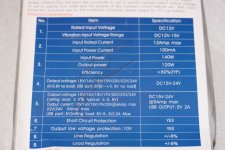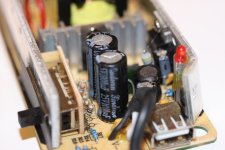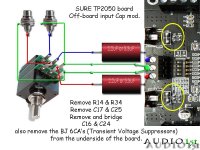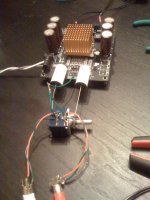While browsing the Tripath docs, I came across the section on Modulator Feedback. One resistor, Rfbc, needs to be matched to the supply voltage "for best signal-to-noise ratio and lowest distortion."
-dr_vega
Dr. Vega, i'm looking on partsconnexion and I've found some resistors besides the holcos you recommended.
TANTALM-146-62650
That one's almost ten bucks whereas the holcos are like 60 cents, and an albrad is 30 cents. What is the reason for the cost difference? Also, do I need .25 or 1 watt resistors for this mod? (I'm looking to match 36v, i.e. 17k)
Also what 2.2uf input caps would you recommend?
Oh, and for the input caps... what voltage rating do I need? They range from about 400-1200 generally from what I saw on partsconnexion.
Oh, and for the input caps... what voltage rating do I need? They range from about 400-1200 generally from what I saw on partsconnexion.
You can get away with 10V or less, AFAIK. The biasing + signal are around -2.5V each.
Dr. Vega, i'm looking on partsconnexion and I've found some resistors besides the holcos you recommended.
TANTALM-146-62650
That one's almost ten bucks whereas the holcos are like 60 cents, and an albrad is 30 cents. What is the reason for the cost difference? Also, do I need .25 or 1 watt resistors for this mod? (I'm looking to match 36v, i.e. 17k)
Also what 2.2uf input caps would you recommend?
I don't know much about the sound of different resistors. I read that the old Holcos are some of the best sounding, but are becoming rare. Parts Connnexion is closing out the old-style Holcos, so they are a super buy.
1/4 watts will work for the feedback resistors. The only resistors that need to be 1 watt are the Zobels.
I haven't installed the Holcos as feedback resistors because I haven't removed the heat sinks. I have replaced the input resistors with Holcos, but I don't think I heard any difference. Your Mileage May Vary.
-dr_vega
You can get away with 10V or less, AFAIK. The biasing + signal are around -2.5V each.
Arrgh, what I wrote is inaccurate, unclear and confusing. I stand by the 10V but "-2.5V each" part is nonsense 🙂
Also what 2.2uf input caps would you recommend?
There's so much discussion on caps. I haven't tried the ultra expensive ones, so I can't comment. Of the ones I've tried, the Dayton Poly foil are the best, but they max at .47 uF so you have to parallel 4 or 5 of them if you have the room. The Dayton Poly films are also very good and you can get the size you want.
I also like some West Cap and Sprague paper-in-oil "vitamin Q type" that I have bought on ebay for almost nothing. They aren't quite as crystal clear as the Poly foils, but they have a lovely liquid quality that is very listenable.
I've been running the Dayton Poly foils and I am constantly amazed at how stunning the system sounds with the air core coils. However I'm considering going back to the paper-in-oil just because I like the sound better even though I know it is ultimately not as accurate and detailed. But, damn, the music is so good through them.
-dr_vega.
An update on the heatsink fan:
Seems like the prayers for those who want a fan and those who want a big heatsink are answered - mine just came with this heatsink:
A side view to see the heatsink's height. They even bundled an extra heatsink shown in the left still in the bubble-wrap.
Seems like the prayers for those who want a fan and those who want a big heatsink are answered - mine just came with this heatsink:
An externally hosted image should be here but it was not working when we last tested it.
A side view to see the heatsink's height. They even bundled an extra heatsink shown in the left still in the bubble-wrap.
An externally hosted image should be here but it was not working when we last tested it.
The input caps have 0V dc on one side, and +2.5V dc on the other. You really do only need 10V working (or even 6.3V working) voltage rating for these.
However I'm considering going back to the paper-in-oil just because I like the sound better even though I know it is ultimately not as accurate and detailed. But, damn, the music is so good through them
Ah.... my sentiments exactly!
Might have to try some of the Russian PIO caps. Merry Christmas.
Also what 2.2uf input caps would you recommend?
BTW, there's nothing magic about the 2.2 uF value. As a general rule, as you drop below 2 uF you may hear some bass rolloff depending on your system and your ears.
Tripath recommends a high pass corner of less than 10 Hz. 1.5 uF gives you just about 10 Hz. 2 uF gives you about 7 Hz. So anything larger than 1.5 uF should sound fine.
You can pretty much go as large as you want. Larger values generally cost more and are physically larger, but they work just as well. The Sprague PIO (paper-in-oil) caps I'm considering going back to are 10 uF.
-dr_vega
This discussion prompted me to go look at my Sprague "PIO" caps. Since Vitamin Qs only go to .1uF, mine were sold as "Vitamin Q type."However I'm considering going back to the paper-in-oil just because I like the sound better even though I know it is ultimately not as accurate and detailed. But, damn, the music is so good through them.
-dr_vega.
I located a Sprague datasheet and here's what I found. "Vitamin Q" refers to the mineral oil used in several lines of PIO caps. .1uF is the largest value for the tube-shaped Vit Qs. There may be some tub-shaped Vit Q caps in larger values.
The Sprague caps I have are 121P and 118P series. The are hermetically sealed tubes and look like Vit Qs. The 121P series (mine are 10uF) are metalized paper in wax. The 118P series (mine are 2uF) are metalized paper and polyester film in wax. Sprague says both of these are top of the line for their types of caps. Sprague says the 118P is better than the 121P.
My experience is that the 118P has a fabulous bass response, but the 121P has more detail and clarity. Both are wonderful to listen to, but I judged the 121P to be superior to the 118P, despite what Sprague says.
I guess the only true PIO caps I've heard are Russian 10 and 20 uF. These are tub-shaped rather than tube-shaped. I found them nicely warm and rich, but a little muddy and unclear. I no longer use them in any of my amps or speakers. I know that the K40 tube-shaped Russian PIOs get good reviews, but I didn't like my tub-shaped ones.
-dr_vega
Air-core EMI condoms
When I first put the air-core coils on, the change was so dramatic that I just reveled in the clarity and detail. But after the newness wears off, you begin to notice the problems that still remain.
There was a coarseness in the treble. I blamed it on my tweeters (BG Neo8s) because they are aggressive and I blame them for everything. In truth they are just very accurate and very unforgiving.
So today I finally got around to making condoms for the rest of my air-coils. Poof! the coarseness is gone. My high treble is also louder. The cymbal orgasm at the end of Patricia Barber's "Too Rich for my Blood" is striking (pun intended).
So even though there is not enough EMI/RFI to bother your neighbors, there is enough to bother you. The simple paper/aluminum foil condoms seem to have done the job. Highly recommended.
-dr_vega
When I first put the air-core coils on, the change was so dramatic that I just reveled in the clarity and detail. But after the newness wears off, you begin to notice the problems that still remain.
There was a coarseness in the treble. I blamed it on my tweeters (BG Neo8s) because they are aggressive and I blame them for everything. In truth they are just very accurate and very unforgiving.
So today I finally got around to making condoms for the rest of my air-coils. Poof! the coarseness is gone. My high treble is also louder. The cymbal orgasm at the end of Patricia Barber's "Too Rich for my Blood" is striking (pun intended).
So even though there is not enough EMI/RFI to bother your neighbors, there is enough to bother you. The simple paper/aluminum foil condoms seem to have done the job. Highly recommended.
-dr_vega
I don't know much about the sound of different resistors. I read that the old Holcos are some of the best sounding, but are becoming rare. Parts Connnexion is closing out the old-style Holcos, so they are a super buy.
1/4 watts will work for the feedback resistors. The only resistors that need to be 1 watt are the Zobels.
I haven't installed the Holcos as feedback resistors because I haven't removed the heat sinks. I have replaced the input resistors with Holcos, but I don't think I heard any difference. Your Mileage May Vary.
-dr_vega
I am the newest member. I just bought the 4X100 from Sure Electronics, so this should be fun. Lot's of mods, eh? Is there a synopsis post somewhere, because this thread is quite long.
The audiophilly Holcos (which are no longer made, me thinks) had copper lead wires rather than steel. Not to pick up magnetic fields.
The fancy and expensive polypropylene caps are for single ended class A tube amps. Each stage has a high output impedance and the quality of the coupling cap makes a big difference. Jung's article Capacitor Test Test showed that the dielectric absorbtion of the cap mattered most when the voltage source had a high output impedance.
My tube amp (which I don't use now) is a Stromberg-Carlson 433 (The Stromberger). The absolute biggest gain in performance was obtained by using polypropylene caps to bypass the power supply at each stage.
I am currently driving my Infinity Interlude 40's with a Kenwood receiver, which has a "chemical capacitor" in the power supply. My CDs sound fine to my 50 year old rock and roll ears.

I am the newest member. I just bought the 4X100 from Sure Electronics, so this should be fun. Lot's of mods, eh? Is there a synopsis post somewhere, because this thread is quite long.
The audiophilly Holcos (which are no longer made, me thinks) had copper lead wires rather than steel. Not to pick up magnetic fields.

Welcome. There's also a thread specifically for the 4*100watt Sure. You might want to check it out. The biggest upgrade bang for the buck is upgrading the input caps and output coils. Of course power supply tweaks pay dividends, too. Everything else is interesting and fun, but the improvement is marginal, IMHO.
Parts Connexion is closing out the old Holcos with non-magnetic leads, that's why they are such a good deal. After Holco was bought, the resistors were cheapened. They now have steel leads and sound like crap, or so I've read.
Happy Christmas everyone.
-dr_vega
Hi all, I want to use this board in my car, the 2*100w version.
I considered connecting it directly to the car battery, but I read in this thread that sound is a good deal better when it gets 24v.
I have a car laptop charger that can supply 24v 5A, I have attached a few pictures of it. Will this manage to supply the amp with enough power?
The amp will drive five 2" drivers on each output, connected in a bessel array, so it wont go much below 150Hz.
Is there perhaps a easy mod I can to to the DC converter to make it more suited for the task?
I considered connecting it directly to the car battery, but I read in this thread that sound is a good deal better when it gets 24v.
I have a car laptop charger that can supply 24v 5A, I have attached a few pictures of it. Will this manage to supply the amp with enough power?
The amp will drive five 2" drivers on each output, connected in a bessel array, so it wont go much below 150Hz.
Is there perhaps a easy mod I can to to the DC converter to make it more suited for the task?
Attachments
Hi all, I want to use this board in my car, the 2*100w version.
I considered connecting it directly to the car battery, but I read in this thread that sound is a good deal better when it gets 24v.
I have a car laptop charger that can supply 24v 5A, I have attached a few pictures of it. Will this manage to supply the amp with enough power?
The amp will drive five 2" drivers on each output, connected in a bessel array, so it wont go much below 150Hz.
Is there perhaps a easy mod I can to to the DC converter to make it more suited for the task?
The power supply should be fine.
I don't know if anyone one this thread has used the Sure 2*100watt at less than 4 ohms. The board is rated for 4 ohms and I would be cautious about letting the Bessel array drop below 4 ohms.
-dr_vega
pot touchy
That should work fine if it is indeed connected as per the photo. Your source must have a very high output level to make it so loud, so soon. Changing the value of the pot shouldn't change the touchiness of the control although 10k might sound better than 50k into the remaining 22k input impedance of the Sure. I would have also soldered the caps, or their wires, to the vacated pad on the board rather than screwing into the terminal. Reinstalling R14,34 would also help drop the level so that you can turn up the pot a little further.
I used a alps 50k "blue velvet" pot. Why is it that a very small turn increases the volume alot? Is there another value pot i can use that will make it not so aggresive? Thanks.
That should work fine if it is indeed connected as per the photo. Your source must have a very high output level to make it so loud, so soon. Changing the value of the pot shouldn't change the touchiness of the control although 10k might sound better than 50k into the remaining 22k input impedance of the Sure. I would have also soldered the caps, or their wires, to the vacated pad on the board rather than screwing into the terminal. Reinstalling R14,34 would also help drop the level so that you can turn up the pot a little further.
- Status
- Not open for further replies.
- Home
- Amplifiers
- Class D
- Sure Electronics New Tripath Board tc2000+tp2050




